TL;DR
TradingView is a browser-based charting platform and screener for cryptocurrencies and other financial assets. Its charting tools are also available to use natively in Binance’s trading UI. Apart from charting, you can also share your trading strategies and live stream your analysis.
When it comes to free options, TradingView is a powerful tool for all experience levels. The basic features should be enough for most traders. However, be careful browsing through other users’ ideas and streams. It’s important to filter out the information that adds value to your strategy rather than blindly following others.
Introduction
For traders who love technical analysis, robust charting tools are essential. TradingView is one option for both amateur and experienced traders. It offers numerous trading and charting tools and also a free membership option. Let’s face it... not everyone has the money or need for a Bloomberg terminal subscription.
If you’ve been trading on Binance, you might have already noticed TradingView’s tools available on the exchange. But without understanding them, it can look a little intimidating. There’s a huge amount to try, but where’s the best place to begin? Dive into our beginner’s guide to see what TradingView can offer.
Want to put your learning into practice?
What does TradingView do?
TradingView is a platform that lets you customize technical indicators, create charts, and analyze financial assets. These indicators are patterns, lines, and shapes that millions of traders use every day. TradingView is entirely browser-based, with no need to download a client. You can also download an app for iOS and Android if you prefer a mobile experience.
TradingView was launched in Westerville, Ohio, in 2011 and now boasts a large user base, with eight million accounts created in 2020 alone. Users can chart and analyze various stocks, commodities, and cryptocurrencies like Bitcoin with either a free or paid account. Once you’ve created strategies and templates, you can publish your findings to the community. This way, you can build your skills with feedback from other TradingView members.
TradingView in Binance
Binance has built-in TradingView tools in its exchange UI, allowing users to create charts and trade simultaneously. The tools you see on the left are just a small selection of what’s available and offer a similar experience to TradingView’s website.
For a quick tour of the interface, find out How to use the Binance Web TradingView Tool.

How expensive is TradingView?
As we mentioned, TradingView is free for anyone to use. There are also paid subscriptions that increase the number of indicators and charts you can view simultaneously. For beginners, a free account with one chart and three indicators is a good start. You’ll also have to put up with adverts, but they aren’t too intrusive. Below you can see more details on the differences in the packages:
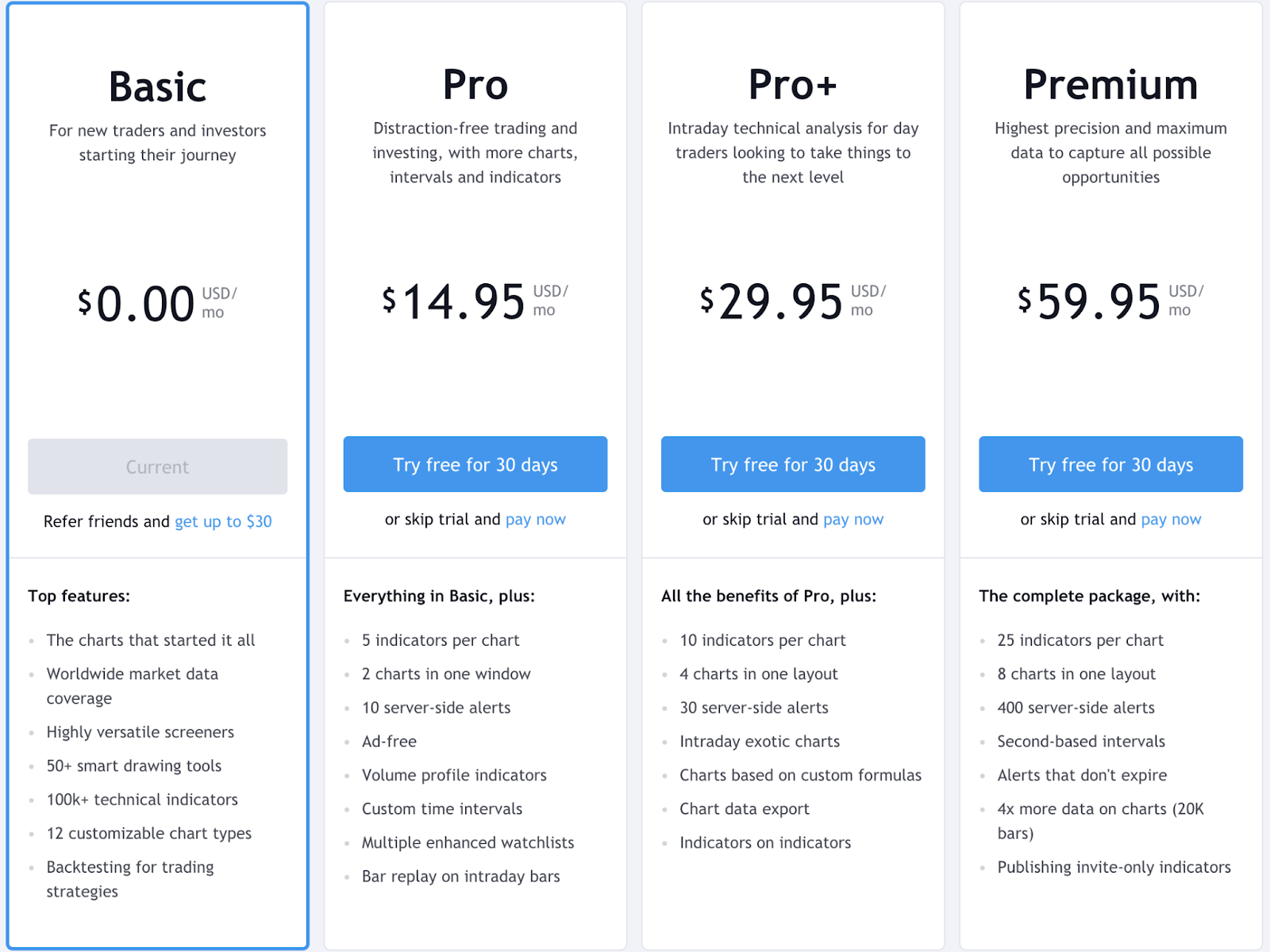
What is TradingView’s social network?
TradingView offers Instagram-like features for sharing and showing off trading strategies. The website’s Ideas and Streams pages give you a chance to pick up tips or get feedback. If you navigate to the Ideas page, you’ll see charts, videos, and commentaries from other users. Community members can also get involved in discussions and chat rooms. But remember that any user can create and share ideas, so be careful. Every trader has a different style and strategy, so you should not take these as financial advice.
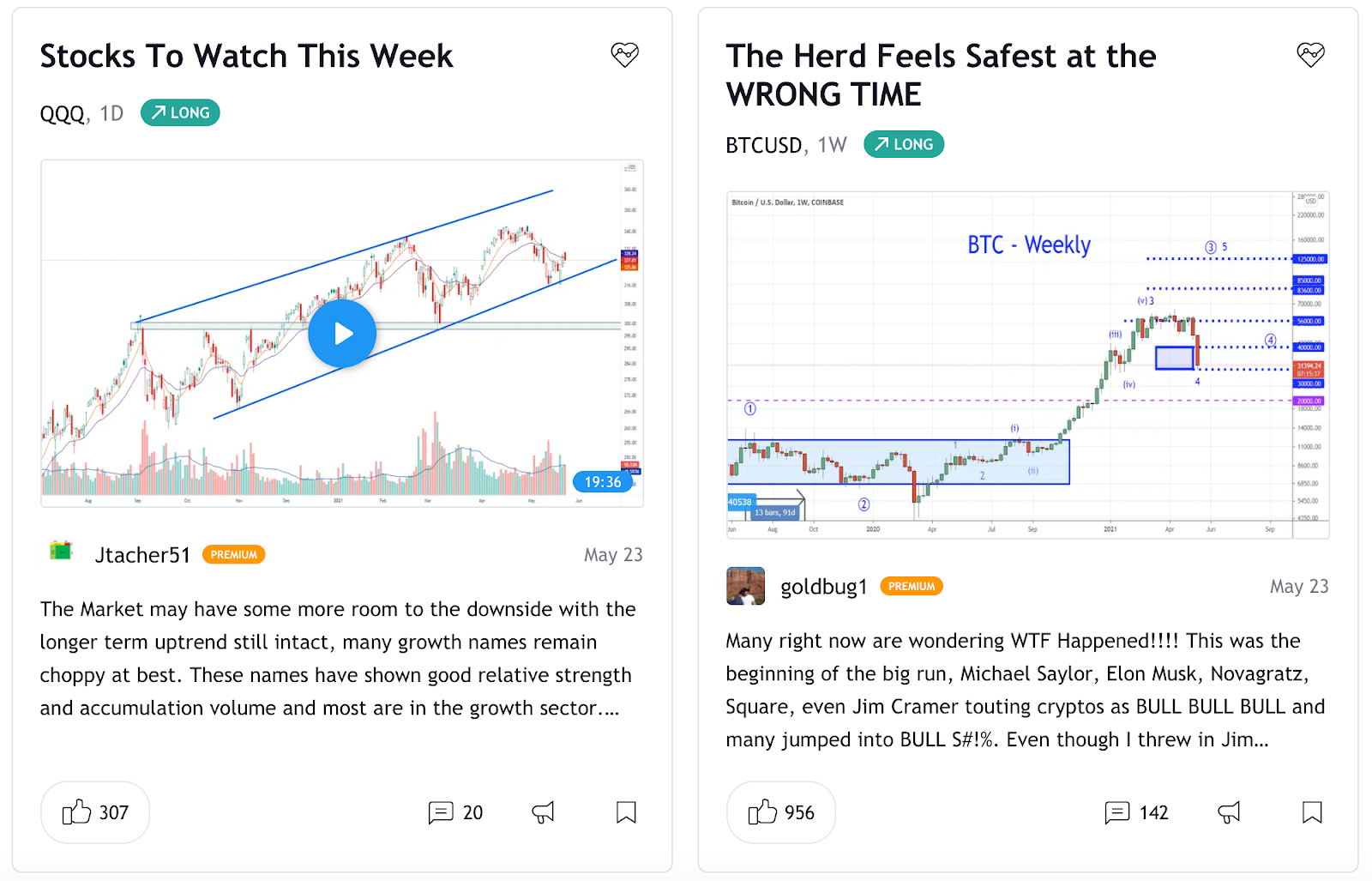
Just like you might watch a Twitch stream of your favorite gamer, TradingView Streams let you observe other traders create charts in real-time. It’s a fun extra feature but still in beta, and the amount of content is relatively low.
Understanding the TradingView UI
If you’ve never used charting tools before, TradingView can look a bit confusing. Let’s break it down a bit first.
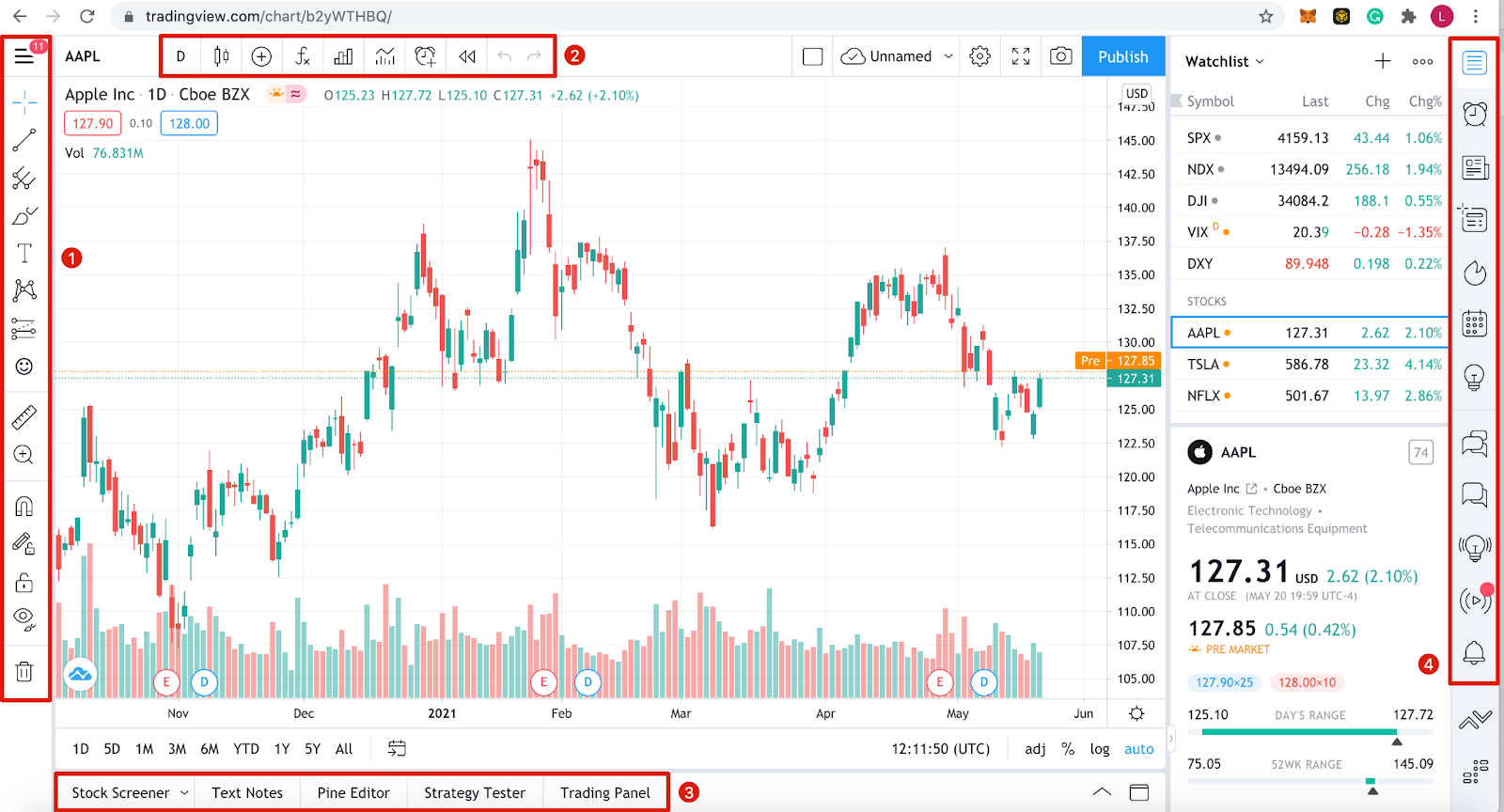
Toolbar 1
This toolbar contains all the charting and drawing tools usable directly in the chart area. From simple lines to long/short positions, there’s a lot to explore. You can also right-click each tool to see an extended selection. Some are more advanced than others, but the default lineup contains enough basics to get started.
Toolbar 2
Here you’ll find options to change the look of the chart. You can choose between candlesticks, line graphs, area graphs, and more. There’s also a search bar to the left to change the asset displayed. Another tool to note is the [Indicators & Strategies] button to insert premade analysis patterns like a moving average.
Toolbar 3
TradingView doesn’t offer a brokerage service, but you can trade within the website using the [Trading Panel] tab. You’ll find a list of partners you can exchange with if you already have an open account with them. You can also backtest your strategies using the [Strategy Tester] function.
Toolbar 4
This section mainly covers news and TradingView’s social elements. You can customize your watchlist, private message other users, explore Ideas and Streams, and access a personalized calendar. If you need to find any data, lists, or information, this is the area to visit.
Chart area
When you change the asset you’re looking at, use any tools, or place indicators, you’ll find them displayed in the main chart area. You can also customize almost everything you see, which we’ll cover in the next section.
Personalizing your TradingView charts
Everyone has their preferences when it comes to chart layout. Customizing colors, lines, and axes makes it easier to read and understand your graphs quickly. You can find all the options you’ll need by right-clicking the graph area and clicking [Settings...].
You can also reset your chart if it gets messy and set custom email price alerts from the [Settings...] menu.

Once you’ve clicked [Settings...] you’ll find yourself in the [Chart settings] window where you can play with a range of options. Let’s quickly go through the basics.
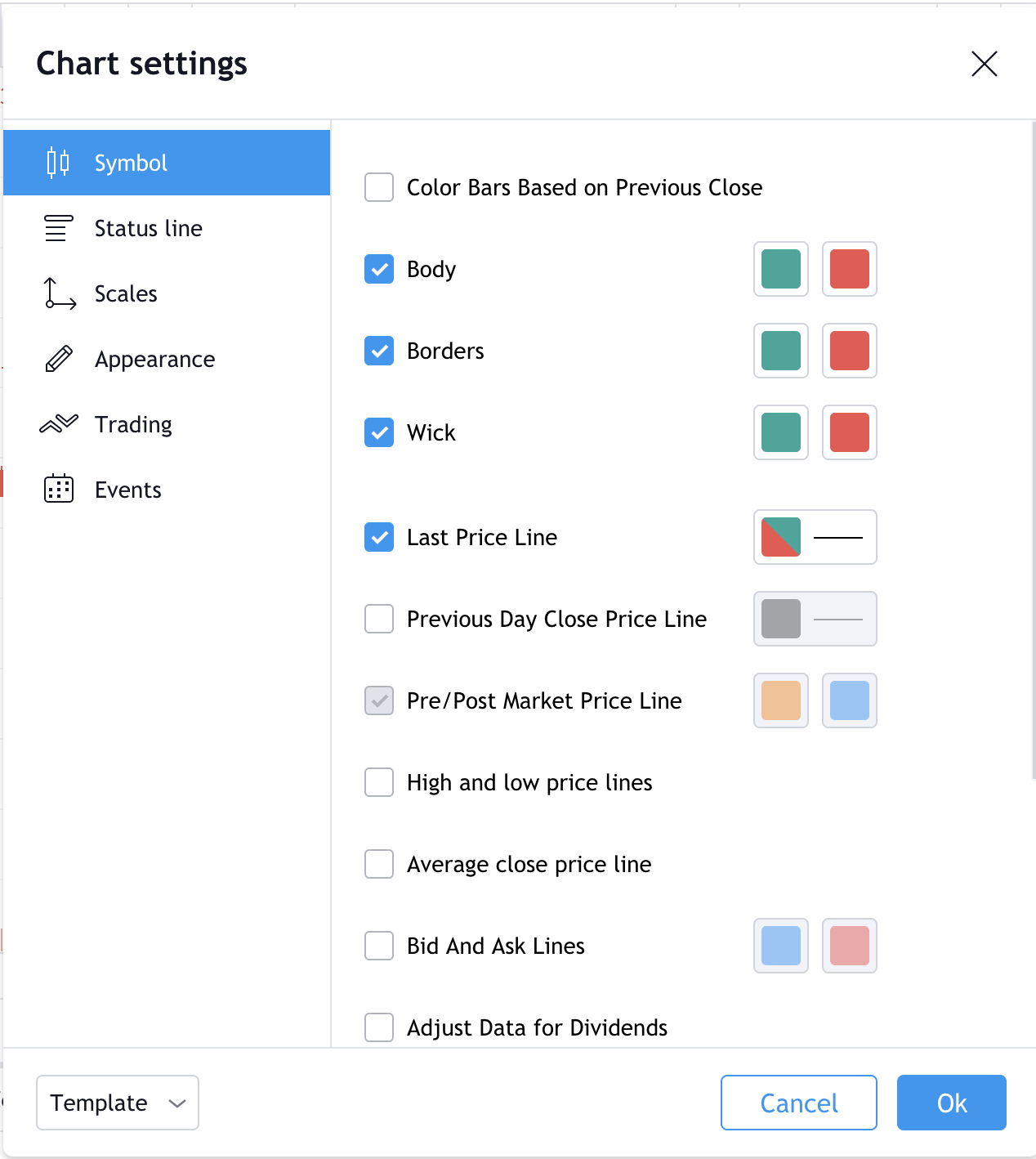
1. [Symbol] lets you change the way that your candlestick charts look. Every part of the candlestick pattern can be color-coded the exact way you like.
2. [Status line] contains options to change the information you’ll find in the top left of the chart, such as OHLC (open, high, low, and close prices) data and buy and sell buttons. The red box shows the lowest ask price (38,345.96), and the blue box the highest bid (38,345.97). In between, you have the bid-ask spread (0.01).

3. [Scales] provides options to change the trackers you can see on the right-hand axis. For example, you could add the day’s high and low prices or the countdown to bar close.
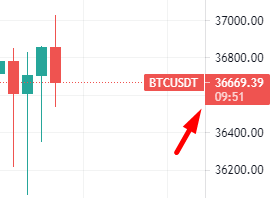
4. [Appearance] lets you change your grid lines, background color, axes, and other cosmetic features.
5. [Trading] allows you to customize visual elements if you’ve logged into a broker account.
6. [Events] gives you options to display dividends, splits, and other events on the chart area.
Along with setting up the chart view, you might also want to change the intervals of your candlesticks or other symbols. To do this, go to the top bar and click the far left button. You’ll now find a long list of different intervals, ranging from seconds to months. You can also favorite some intervals so they will show up on your top bar.
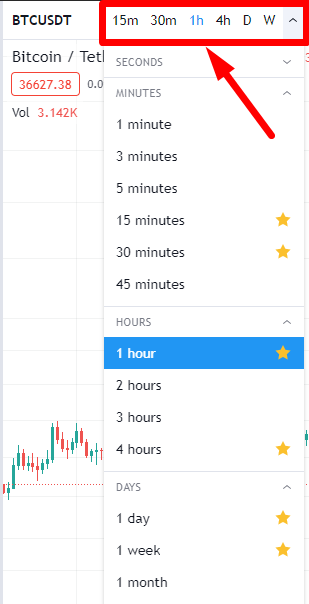
Once you start customizing your chart, there’s no need to save it manually. TradingView saves all your edits in real-time, so you can log out and come back to them later.
Drawing trend lines
For your first chart, you can’t go wrong with a trend line. It’s a beginner-friendly way of modeling price action and one of the most commonly used chart patterns for day trading and swing trading.
1. To start the tutorial, select the line tool from the left side toolbar.
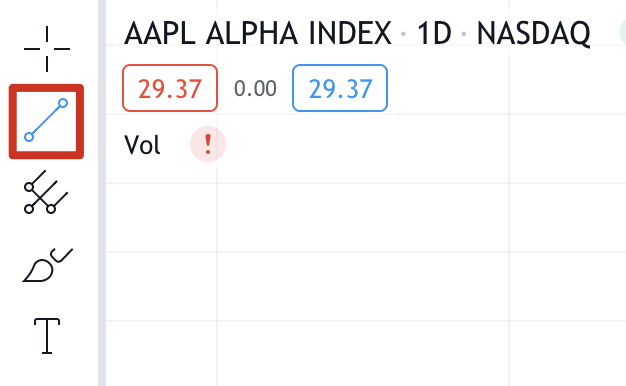
2. You also might want to turn on the magnet tool. Your lines will snap to any nearby OHLC points, which is helpful for improved accuracy.
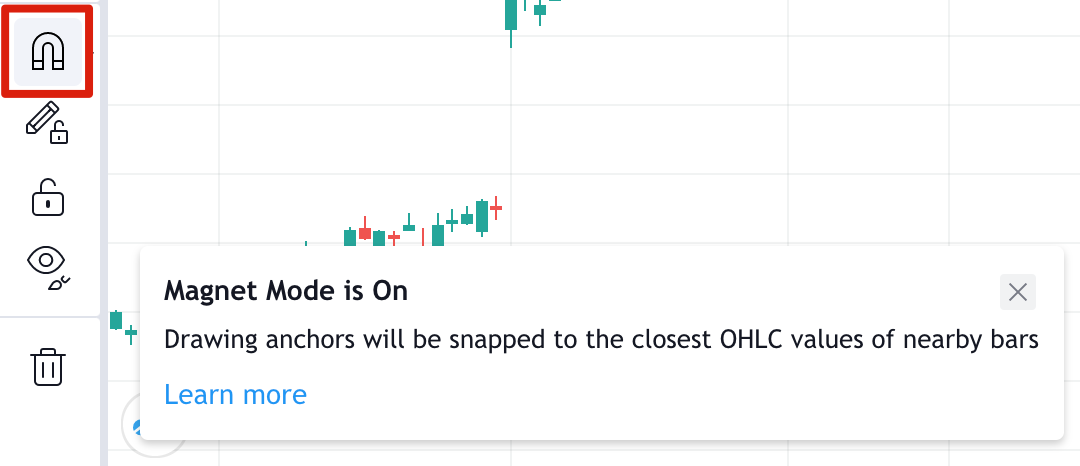
3. For a downtrend, start at a local high point (point 1) before a price dip, known as a swing high. Click where you want the line to start and try to include as many highs as possible. Click again when you want to complete your trend line.
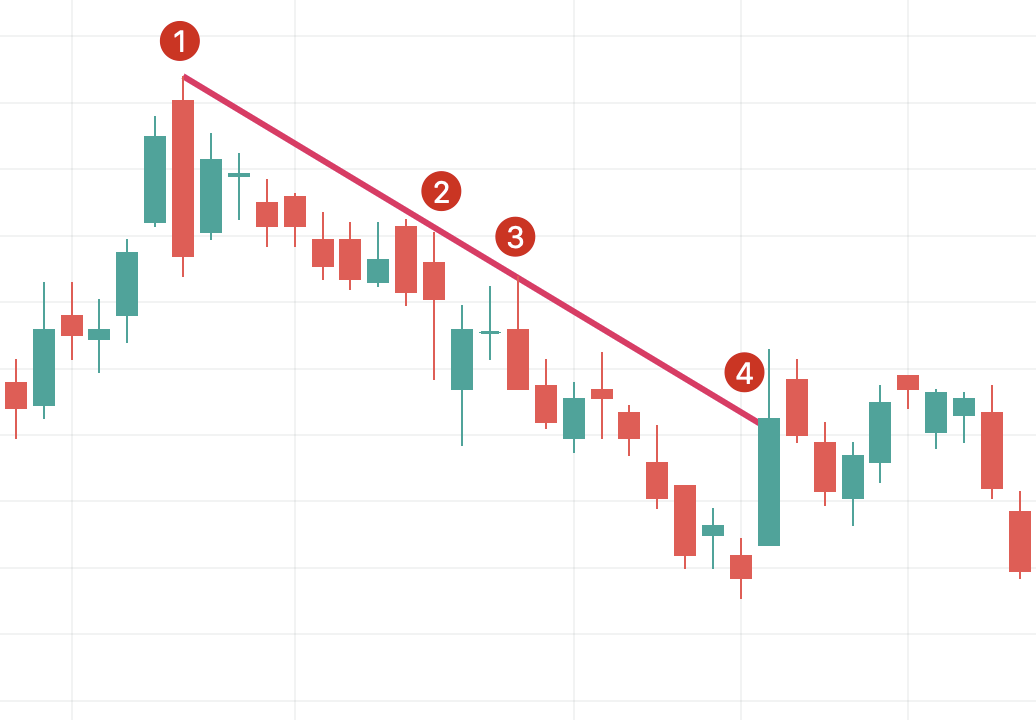
Points 1, 2, and 3 indicate points of resistance. It’s always best to have at least three points testing your trend line, as two points could be coincidental. Point 4 shows a breakout from the trend, meaning that it’s best to draw a new trend line.
Once you have an established downtrend, one possible strategy is to sell when the price meets and tests your line. If you decide to draw an uptrend, make sure you start your line using a low price so that the line is underneath your candlestick.
For more information on this, please check The Basics of Support and Resistance Explained.
Drawing a pitchfork
A pitchfork is a more advanced chart that develops the trend line concept. The technical indicator was created by Alan Andrew, a famous 20th-century American investor and educator. It’s easy to draw and provides more insight than a simple trend line, so let’s go through it step-by-step.
1. To begin, select the pitchfork tool underneath the line tool.
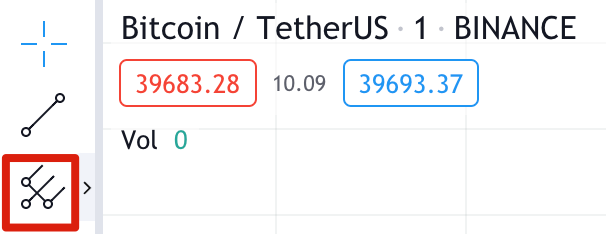
2. We’re going to create our pitchfork by picking three points at the beginning and end of trends.
3. You can see in the example below that we’ve started with point 1, the swing low of a downtrend. We’ve then clicked point 2, the swing high of an uptrend, followed by point 3, the swing low of the next downtrend.
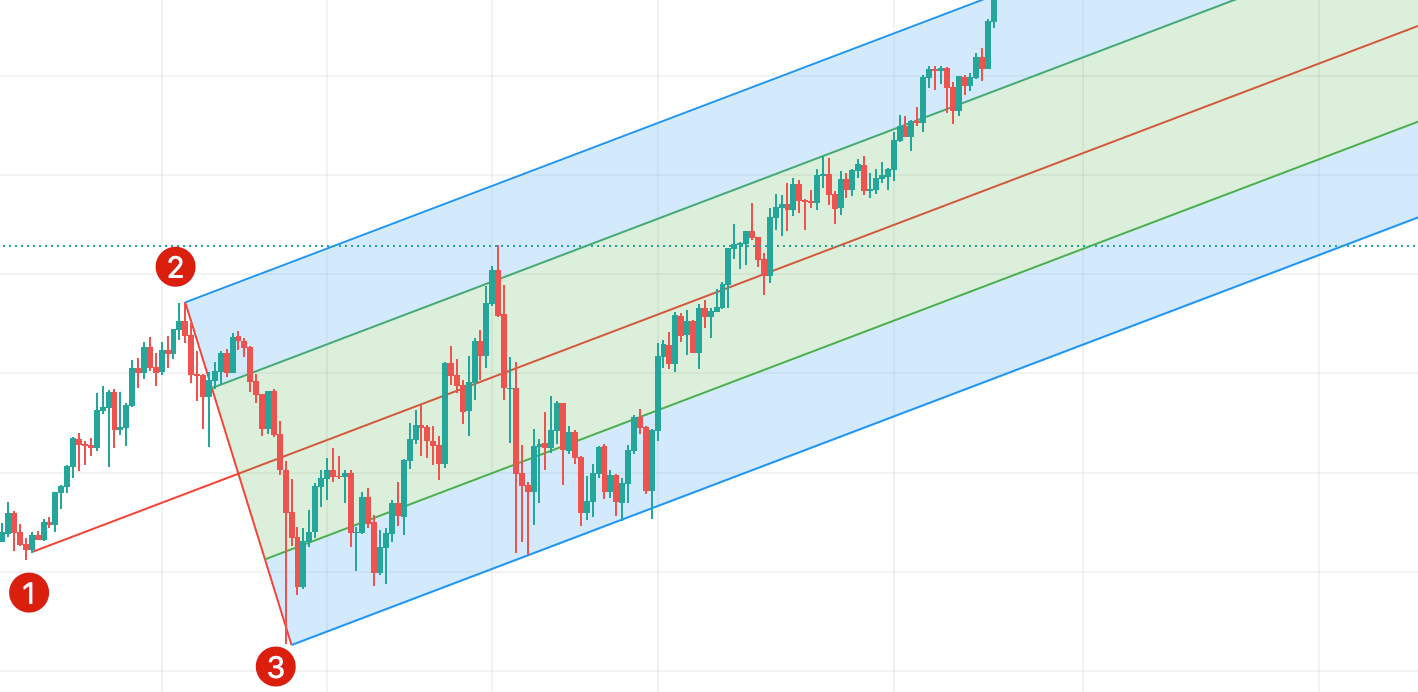
4. These points create a pitchfork shape, with the top line extending from point 2 showing the resistance level and the bottom line extending from point 3 showing the support level. The median line is where the price is expected to gravitate towards.
5. Similar to our trendline example, the support line shows possible areas to buy and the resistance line where you could sell. You could also place a stop-loss order just below the bottom trendline as a risk management method. Note that, just like any other indicator, pitchfork won’t always work as expected. Consider combining it with other tools and strategies to reduce the risks.
If you’re interested in learning more, check out How To Create TA Indicators on TradingView.
Pros and cons of TradingView
TradingView is just one choice out of many when it comes to asset screeners. Most offer a similar set of charting and trading tools, but let’s take a look at the main aspects. TradingView certainly does some things very well, but there is also room for improvement.
Pros
HTML5 charting - Any device with an internet browser can access TradingView. You don’t need to install any software and can view your charts anywhere.
Free membership - Anyone can access the majority of features available.
Server-side alerting system - If you set an alert, TradingView will keep track of this on their servers. You don’t need to have TradingView open to receive alert notifications.
Binance compatibility - While you can’t access Binance from TradingView’s website, you can use TradingView in Binance’s trading UI. You can easily buy and sell crypto with Binance and also create charts on the fly.
Scripts - More advanced users can create custom indicators saved to TradingView’s servers. This feature is powered using Pine Script, TradingView’s custom coding language that is simple to use.
Asset selection - There’s a considerable amount of equities, securities, commodities, and forex info available to chart. We’re not just limited to cryptocurrencies here!
Backtesting - Once you’ve developed a strategy, it’s simple to backtest using the inbuilt feature.
Cons
Community issues - While the Streams and Ideas tab concept is interesting, the quality of what you’ll find varies greatly. A lot of advice given is highly speculative and not very helpful for new users. The comments section also has occasional trolling.
Customer support - The TradingView community commonly reports problems with TradingView’s customer support. Only paying customers can raise issues, and free users receive no support.
Brokerage integration - TradingView has incorporated some brokers and trading platforms, but the options are still quite limited.
Cboe BZX data - TradingView’s prices for U.S. stocks don’t come directly from their associated stock markets. NASDAQ stocks, for example, get their price from the Cboe BZX exchange, which can differ slightly from the actual price. Real-time data from an exchange is available for a fee.
Trading doesn't have to be difficult
Closing thoughts
For anyone looking for a free solution with a significant amount of tools to use, TradingView is a solid option to explore. Their educational material is also free to access and easily covers the basics of charting and technical indicators in detail.
The social side, however, isn’t so strong. Chat rooms often contain speculative advice that you should avoid. This factor makes the social aspects less valuable for beginners as you need to sift through good and bad advice.
Nevertheless, TradingView is worth trying for its chart tools alone and is a great place to backtest trading strategies. Technical analysis is a deep topic, and you'll have more than enough to explore with just a free account.
Disclaimer: The content presented here is for educational purposes. This article is not an endorsement or recommendation, and the information provided should not be regarded as financial advice. All screenshots were taken from TradingView's official website and are in accordance with their Terms of Use.
